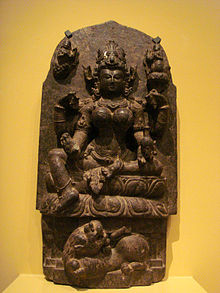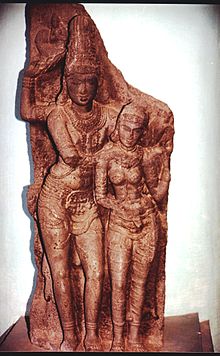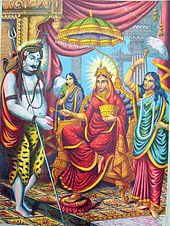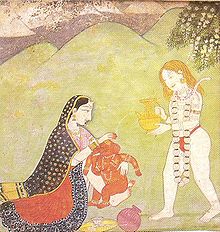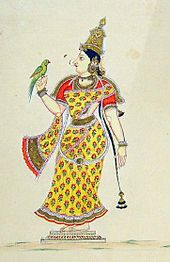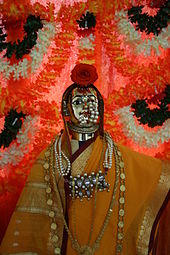Maha Shakti
|
Parvati (Devanagri: पार्वती, IAST: Parvati) is known as the motherly form of Mother Goddess Gauri Jagadamba, Parvati is another form of Shakti, the wife of Shiva and the gentle aspect of Maha Devi or Durga, the Great Goddess. Parvati is considered to be a complete incarnation of Adi Parashakti or Goddess Durga, with all other Goddesses being her incarnations or manifestations. Parvati is nominally the second consort of Shiva, the Hindu God of destruction and rejuvenation. However, she is not different from Sati, being the reincarnation of Shiva's first wife. Parvati is the mother of the gods Ganesha and Kartikeya. Some communities also believe her to be the sister of Vishnu. She is also regarded as the daughter of King Himavan. Parvati, when depicted alongside Shiva, generally appears with two arms, but when alone, she is depicted having four, eight or ten arms, and is astride on a tiger or lion. Generally considered a benevolent Goddess, Parvati also has wrathful incarnations, such as Durga, Kali, Tara, Chandi, and the Dasha Mahavidyas (ten great wisdoms) Kali, Tara, Tripur Sundari (Shodashi), Bhuvaneshwari, Bhairavi, Chinnamasta, Dhumavati, Bagla Mukhi, Matangi and Kamala, as well as benevolent forms like Katyayani, Maha Gauri, Kamalatmika, Bhuvaneshwari and Lalita. Etymology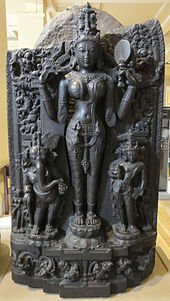
Parvati as four-armed Lalita with her sons Ganesha and Skanda, Odisha, India. 11th century sculpture from the British Museum. 1872,0701.54 . Parvata is one of the Sanskrit words for "mountain"; "Parvati" translates to "She of the mountains" and refers to Parvati being born the daughter of Himavan, lord of the mountains and the personification of the Himalayas. Other names which associate her with mountains are Shailaja (Daughter of the mountains), Adrija or Nagajaa or Shailaputri (Daughter of Mountains), 'Haimavathi' (Daughter of Himavan) and 'Girija' or 'Girirajaputri' (Daughter of king of the mountains). Parvati's name is also sometimes considered a form of 'pavitra', meaning 'sinless' or 'holy' in Sanskrit. Her consort is Shiva and she is the sagun swaroop of the Supreme Being Adi Parashakti that is the material form of the supreme power. She is also known by 108 names from the Durga Saptashati. These include Durga (invincible), Shakti (power), Ambika ('dear mother'), Gauri ('fair complexioned'), Bhairavi ('ferocious'), Kali ('dissolver of time'), Uma, Lalita, Mataji ('revered mother'), Sahana ('pure'), Maheshwari ('great goddess'). Bhavani, Shivaradni ('Queen of Shiva'), and many hundreds of others. The Lalita sahasranama contains an authoritative listing of 1,000 names of Parvati. Two of Parvati's most famous epithets are Uma and Aparna. The name Uma is used for Sati in earlier texts, but in the Ramayana, it is used as synonym for Parvati. In the Harivamsa, Parvati is referred to as Aparna ('One who took no sustenance') and then addressed as Uma, who was dissuaded by her mother from severe austerity by saying u ma ('oh, don't'). The apparent contradiction that Parvati is addressed as the fair one, Gauri, as well as the dark one, Kali or Shyama is a philosophical matter. It suggests that the one calm and placid wife, Uma, in times of danger, can transfer back to her primal fierce and angry or (sometimes) Maternal nature as Kali, who stands uncloaked, with a foot on her husband's chest. The twin opposite colors, white and black represent the two opposing nature of the Goddess. Parvati is also the goddess of love and devotion, or Kamakshi. Parvati as Goddess of PowerSarvarupe Sarveshe Sarvashakti Samanvite Bhayebhyastrahi no devi durge devi namostute It translates to: We bow down to Devi Durga, who is source of all forms (sarvarupe), who is the goddess of all beings (sarveshe), in whom all power exists (Sarvashakti samanvite) and who destroys all fear (bhaye bhyastrai no devi). It is also believed that without her Shiva remains as Shava or Corpse, for she is the ultimate source of power for all beings, gods and Devas. Rise to prominenceParvati herself does not explicitly appear in Vedic literature, though the Kena Upanishad (3.12) contains a goddess called Uma-Haimavati. She appears as the shakti, or essential power, of the Supreme Brahman. Her primary role is as a mediator who reveals the knowledge of Brahman to the Vedic trinity of Agni, Vayu, and Indra, who were boasting about their recent defeat of a group of demons. But Kinsley notes: "it is little more than conjecture to identify her with the later goddess Sati-Parvati, although [..] later texts that extol Siva and Parvati retell the episode in such a way to leave no doubt that it was Siva's spouse.." Both textual and archaeological evidence suggests Sati-Parvati appears in the epic period (400 BC–400 AD), as both the Ramayana and the Mahabharata present Parvati as Shiva's wife. However, it is not until the plays of Kalidasa (5th-6th centuries) and the Puranas (4th through the 13th centuries) that the myths of Sati-Parvati and Shiva acquire more comprehensive details. Kinsley adds that Parvati may have emerged from legends of non-aryan goddesses that lived in mountains. Prof. Weber suggests that like Shiva is combination of various Vedic gods Rudra and Agni, the Puranic Parvati is a combination of Uma, Haimavati, Ambika and earlier Parvati, identified as wives of Rudra; of others like Kali, who could be a wife of Agni and of Gauri and others inspired by Nirriti. Tate suggests Parvati is a mixture of the Vedic goddess Aditi and Nirriti,and being a mountain goddess herself, was associated with other mountain goddesses like Durga and Kali in later traditions. Birth and marriageThe Puranas repeatedly tell the tale of Sati's marriage to Shiva against her father Daksha's wishes and her subsequent self-immolation at Daksha's sacrifice, leaving Shiva grief-stricken and having lost interest in worldly affairs. In the Brahma Vaivarta Purana, Sati appears before Shiva, in her divine form, and reassures him that she will return as the daughter of Himavan. Sati is reborn as Parvati, the daughter of Himavat and Minavatiand is named Parvati, 'daughter of Himavant ' . Sati, as well as Parvati, are considered manifestations of Mahadevi, the great Goddess. In the Ramayana, the river goddess Ganga is depicted as the elder sister of Parvati. In the Harivamsa, Parvati has two younger sisters called Ekaparna and Ekapatala. According to Devi Bhagawata Purana and Shiva Purana mount Himalaya and his wife Mena perform extreme austerities to appease the goddess Adi Shakti. Pleased with their penance the Adi Shakti agrees to be born as their daughter. When born goddess Parvati has four arms and manifests a divine light which pervades the entire Himalaya region on the auspicious tritiya day. Mena implores to the child to withdraw its four armed form and make herself visible as a two armed normal child to which the goddess agrees and becomes a normal girl child. 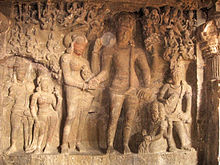
Wall carvings in Ellora Caves- A scene depicting Kalyanasundara - the wedding of Shiva (four armed figure, right) and Parvati (two armed, left). Parvati is depicted as interested in Shiva's tales and appearance from her very birth and eventually remembering her previous life as Sati. As Parvati grows into a young woman, she begins tapas (austerities) to please Shiva to grant her wish to reunite with him. She is portrayed as surpassing all other ascetics in austerity, undergoing severe mortifications and fasting. Finally, Shiva tests her devotion by appearing himself in disguise to criticize Shiva. Untouched by the act, Parvati retains her desire for Shiva, compelling him to marry her. After the marriage, Parvati moves to Mount Kailash, the residence of Shiva. Kalidasa's epic Kumarasambhavam ("Birth of Kumara") details with matchlessly lyrical beauty the story of the maiden Parvati: her devotions aimed at gaining the favor of Shiva, the subsequent annihilation of Kamadeva, the consequent fall of the universe into barren lifelessness, the subsequent marriage of Parvati and Shiva, the birth of Kumara, and the eventual resurrection of Kamadeva after Parvati intercedes for him to Shiva. Main forms of ParvatiAs per devi bhagwata Purana, Goddess Parvati is lineal progenitor of all other goddesses. She is one who is source of all forms of goddesses. She is worshiped as one with many forms and name. Her different mood brings different forms or incarnation.
Several Incarnations of the Goddess
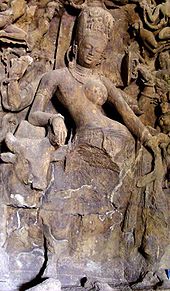
Ardhanarishvara, Elephanta Caves. The sculpture's left is female and the right is male, depicting Parvati and Shiva. Parvati's legends are intrinsically related to Shiva. In the goddess-oriented Shakta texts, that she is said to transcend even Shiva, and is identified as the Supreme Being. Just as Shiva is at once the presiding deity of destruction and regeneration, the couple jointly symbolise at once both the power of renunciation and asceticism and the blessings of marital felicity. Parvati thus symbolises many different virtues esteemed by Hindu tradition: fertility, marital felicity, devotion to the spouse, asceticism, and power. Parvati represents the householder ideal in the perennial tension in Hinduism in the household ideal and the ascetic ideal, re presented by Shiva. In classical Hindu mythology, the "raison d’être" of Parvati, and before that of Sati, is to lure Shiva into marriage and thus into a wider circle of worldly affairs. Parvati tames Shiva, the "great unpredictable madman" with her presence. When Shiva does his violent, destructive Tandava dance, Parvati is described as calming him or complementing his violence by slow, creative steps of her own Lasya dance. In many myths, Parvati is not as much his complement as his rival, tricking, seducing, or luring him away from his ascetic practices. Again, Parvati subdues Shiva's immense sexual vitality. In this context, Shiva Purana says: 'The linga of Shiva, cursed by the sages, fell on the earth and burnt everything before it like fire. Parvati took the form of a yoni and calmed it by holding the linga in her yoni'. The Padma Purana also tells the story of Parvati assuming the form of yoni to receive lingam of Shiva, who was cursed by sage Bhrigu to be the form of the lingam. Three images are central to the mythology, iconography and philosophy of Parvati:
These images that combine the two deities, Shiva and Parvati, yield a vision of reconciliation, interdependence and harmony between the way of the ascetic and that of a householder. The couple are often depicted in the Puranas as engaged in "dalliance" or seated on Mount Kailash or discussing abstract concepts in Hindu theology. Occasionally, they are depicted as quarrelling. In stories of the birth of Kartikeya, the couple are described as love-making generating the seed of Shiva. Parvati's union with Shiva symbolises the union of a male and female in "ecstasy and sexual bliss". Shaiva approaches tend to look upon Parvati primarily as the Shiva's submissive and obedient wife and helpmate. However, Shaktas focus on Parvati's equality or even superiority to her consort. The story of the birth of the ten Mahavidyas (Wisdom Goddesses) of Shakta Tantrism. This event occurs while Shiva is living with Parvati in her father's house. Following an argument, he attempts to walk out on her. Her rage manifests in the form of ten terrifying goddesses who block Shiva's every exit. As the scholar David Kinsley explains,
Aum Girijayai cha vidmahe Shivapriyayai cha dhimahi tanno durgah prachodayat May the goddess Durga, who is the daughter of the mountains and the beloved of lord Shiva illumine me with spiritual wisdom Sarvamangala mangalye shive sarvardha sadhike sharanye tryambake gouri narayani namostute I bow down to and take the refuge of the three eyed Mother Gouri(Parvati) of fair countenance,who is the embodiment of supreme auspiciousness,the giver of all the benedictions,the beloved of Lord Shiva and the power of lord Narayana. Relationship to VishnuDuring the initial stages when Parvathi was performing intense puja to Shiva to obtain Shiva as her husband, Shiva kept testing her by destroying the Shiva lingam she constructed to perform puja. Vishnu then helped in constructing a Shiva lingam for Parvati which was not destroyed by Shiva because of the respect Shiva had towards Vishnu.Thus Vishnu helped Paravthi in continuing her puja for Shiva. This is when Parvathi tied a knot to Vishnu's hand and claimed him as her brother. This is the reason during the marriage of Shiva and Parvathi, Vishnu got involved in all the ceremonies that are supposed to be done by the bride's brother. This is how Parvati is related to Vishnu as a sister. Mother of GaneshaThough Ganesh considered to be son of Shiva and Parvati, the Matsya Puran, Shiva Puran and Skand Puran ascribe the birth of Ganesh to Parvati only, without any form of participation of Shiva in Ganesh's birth. Once while Parvati yearned to take a bath, there were no attendants around to guard her and stop anyone from accidentally entering the house. Hence she created an image of a boy out of turmeric paste which she prepared to cleanse her body, and infused life into it, and thus Ganesh was born. Parvati was overjoyed that her own son was born and she ordered Ganesh not to allow anyone to enter the house, and Ganesh obediently followed his mother's orders. After a while Shiva returned and tried to enter the house, Ganesh stopped him. Shiva requested the child very politely but failed, Lord Shiva assigned his men to straighten out the boy. Shiva's men were carrying weapons but the boy was not affraid of Lord Shiva's men, he was a proficient warrior, he beat them with a stick. The Gods were watching from above the sky, so did Lord Brahma and Lord Vishnu, they all went to Shiva. Shiva's men told Lord Shiva that the boy had hurt them. Shiva told Lord Vishnu and Brahma that a naughty boy had appeared in Kailash, Lord Brahma and Vishnu had an idea, they would disguise themselves as saints and go set the boy straight. When the disguised saints came to Ganesh, he did not know that Lord Brahma and Vishnu's identities were hidden, the saints tried to reason with the boy so that he apologize to Shiva but failed. Indra came with his huge, heavenly army, Parvati came to know about the boy in trouble with the huge army, she was furious and created two Goddesses, Kali and Gauri, she ordered them to help Ganesh to kill the huge army of Indra, so when the army tried to attack Ganesh, Gauri and Kali attacked them first, Kali used her scimitar to behead the armies of Indra and Gauri used her trident to stab them. Meanwhile, Indra fled the battlefield and got the news about Kali and Gauri helping Ganesh, Shiva came to the battlefield where Ganesh was standing, Shiva asked him to move but to no avail. Ganesh even waged a war so that Shiva lost his temper and beheaded Ganesh with his trident. When Parvati came out and saw her son's lifeless body, she was very angry, she started to question all Gods, even Lord Shiva why he killed Ganesh. Lord Shiva tried in vain to reason with Parvati. She immediately revealed her true self as Adi Shakti, she threatened to destroy everyone and everything. She called upon the nine forms within her, the nine forms surrounded her, namely, Shailputri, Brahmacharini, Chandraghanta, Kushmanda, Skandmata, Katyayani, Kaal Ratri, Maha Gauri and Siddhidatri. She ordered them to destroy the whole world and the Gods and the humans. She advised them that if her son does not get back to life, then everyone and everything will be destroyed completely and the Nava Durga vanished and left to go destroy different worlds--Siddhidatri chose the sky, Kushmanda chose the outer space, Kaal Ratri chose the earth, Chandraghanta chose the battlefield, Brahmacharini chose the heavens, Katyayani chose the hell, Skand Mata chose houses of saints, Maha Gauri and Shailputri chose the Gods, humans and saints, to get them all destroyed. Meanwhile, Adi Shakti demanded that Shiva restore Ganesh's life at once. The Gods prostrated at her feet and ordered Lord Vishnu, Lord Brahma, Lord Shiva, Indra, Demi Gods and Shiva's men all together to travel north and return with the first animal in sight. Adi Shakti vanished, leaving the headless human body of Ganesh, lying. She went to destroy the 24 worlds with her nine manifestations, her nine powers were out for apocalypse. They were surrounding Adi Shakti from all sides to damage more. Meanwhile, Lord Vishnu, Lord Brahma, Lord Shiva, Indra, Demi Gods and Shiva's men were all inspecting the destruction that Adi Shakti and her powerful Navdurga forms did, entirely all the creatures were destroyed, so were the humans. Entirely all of the Godly army back in Kailash were destroyed by Kali and Gauri, they disappeared very quickly when Lord Shiva, Vishnu, Brahma, Indra's Gods and Shiva's men were on their way back to Kailash. One creature was not destroyed. Lord Shiva was happy this one creature was not killed, Lord Vishnu cuts the elephant's head with his discus. Lord Brahma creates the same elephant head and attaches it to the elephant's body again. The elephant's head was attached to Ganesh's body, bringing him back to life. Adi Shakti and her furious nine forms were extremely busy destroying the whole world when they heard a tiny voice: 'Mother'? Adi Shakti knew it was her son Ganesh, she hurried back to Kailash, with her nine forms, Shiva showed the Goddess her son with an elephant's head, her nine Navdurga forms went back inside her body. Adi Shakti re-appeared as Parvati and saw Ganesh, she was extremely pleased that her son was alive again, Shiva declared that the child be made head of the ghost-followers (Ganas) of Shiva and worshipped by everyone before beginning any activity, and Gods accepted this condition. Ganesh is identified as a God named after his mother. He is called Umaputra, Parvatisuta, Gaurisuta meaning son of Parvati and Heramba, "mother's beloved son". Iconography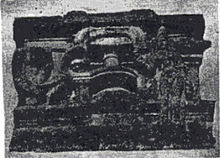
Statue at the Mayuranathaswami Temple, Mayiladuthurai depicting Parvathi in the form of a peahen worshipping a shivalinga, the symbol of god Shiva Naturally, Parvati's unique characteristics have become more and more obscured, as she absorbed more and more goddesses into her iconography. Therefore, her depictions have become rather generic today. When shown with Shiva, she carries a blue lotus in full bloom, shows the abhaya mudra (hand gesture of fearlessness) and usually has one of her children on her knee. The only hint of her former occult status is the somewhat languid appearance of her eyes, as one who has recently emerged from deep meditation. Other goddesses are usually shown with large staring eyes as this is considered a mark of beauty. The consorts of the other two Gods of the trinity, Saraswati and Lakshmi, may be depicted alone, but Parvati hasn’t been depicted this way for many centuries. The goddess is usually represented as a fair and beautiful. Images of Parvati, wearing a sacred thread something not many women are associated with and as this marks the second-birth or dwija it is seems an advanced concept far beyond early pashupatas, and with her hair styled in a top knot like a Rishi (seer) survive into the Chola period (approximately ninth century A.D.). In fact, these two particularities were the only means of distinguishing her statuary from the images of the Goddess Shri of the time. Her Mudras (symbolic hand gestures) are Kataka—fascination and enchantment, Hirana—the antelope, the powers of nature and the elusive, Tarjani—gesture of menace, and Chandrakal—the moon, a symbol of intelligence. Kataka must be affected by one of the foremost hands as it is a means of drawing the worshiper closer. Tarjani must be described with the left hand, which symbolises contempt, and usually in the back set of hands. If Parvati is depicted with two hands, then Tarjani and Chandrakal may be dropped but Hirana and Kataka are signature except in very modern representations, where Abhaya (fearlessness), and Varada, (beneficence), are used. MountParvati's Vahana (animal vehicle), is usually considered to be a Lion nowadays, in her form as Durga, but was probably originally one of the mountain lions native to the Himalayas. It was also, likely, a Lioness, as Parvati's cult is so exclusively feminine. Association with other goddessesIn several myths, the presence of a dark, violent side of this otherwise benign Parvati is suggested. When approached by the gods to defeat demons, Parvati morphs back to her true self, shakti, which is pure energy, untamed, unchecked and chaotic. Her wrath crystallizes into a dark, blood thirsty, tangled-hair Goddess with an open mouth and a drooping tongue. This goddess is usually identified as the terrible mahakali or Kali. In Linga Purana, Parvati summons Kali on the request of Shiva, to destroy a female asura (demoness) Daruka. Even after destroying the demoness, Kali's wrath could not be controlled. She ran around the three worlds in her mad, blind fury and creation was endangered. To lower Kali's rage, Shiva appeared as a crying baby in the middle of a battlefield. In Skanda Purana, Parvati is said to have assumed a form of a warrior-goddess and defeated a demon called Durg who assumes the form of a buffalo. Thereafter, she is by the name Durga. In myths relating to her defeat of demons Sumbha and Nisumbha, Durga emerges from Parvati when Parvati sheds her outer sheath, which takes an identity of its own as a warrior goddess. Although Parvati is considered to be synonymous with Kali, Durga, Kamakshi, Meenakshi, Gauri and many others in modern day Hinduism, many of these “forms” or incarnations originated from different sects, or traditions, and the distinctions from Parvati are pertinent. The Shastras (sanctioned works of religious doctrine) attribute the golden colour of goddess Gauri's skin and ornaments to the story of Parvati casting off her unwanted dark complexion after Shiva teased her, but the cult of Gauri tells a different story. Gauri is in essence a fertility Goddess, and is venerated as a corn mother which would seem to suggest that she owes her colouring to the hues of ripening grain, for which she is propitiated. So whatever be said, Goddess Parvati has two main forms, what actually shaktas says out of which one is Lalita who is Supreme in Srikula family of shaktism and second one is Durga or kali who is supreme in kalikula family. Attainment of the name DurgaDemon Durgasur takes over the three worlds by absorbing the vedas which are the sources of power to the gods by the grace of Lord Brahma. The Gods go to Lord Shiva for help who requests Parvati to kill Durgasur. The reason being, Parvati, the original representation of Adi Shakti, the source of power to the vedas themselves, could palpably be the only recourse to destroy Durgasur even if he had the vedas protecting him. She creates a clone of herself in the form of a damsel messenger known as Kaal Ratri. Parvati orders Kaal Ratri to go to Durgasur to send a message to him asking him to surrender heaven back to the gods. Kaal Ratri tells Durgasur that Parvati had sent her as a messenger and gave him a chance to surrender.Durgasur,furious,orders his soldiers to take her to custody. Kaal Ratri assumes a gigantic size as her annihilative form and vanishes. Back at Kailasa Parvati imbues Kaal Ratri inside her body again and appears in the war field to fight Durgasur. Parvati gives her introduction to Durgasur that she is nature,the primodial power, not any God, man or a demon and after a long battle destroys him. Since she destroyed the demon durgasur she was henceforth praised by the gods as Durga This story has been taken from Srimad Devi Bhagavata Mahapurana. There is a general confusion in India regarding Durga being a combination of Parvati,Lakshmi and Sarasvati. But this is false as Durga is a form of Parvati. There has never been an involvement of Lakshmi or Sarasvati regarding Durga unlike those shown in popular mythological television shows. The exact chapter of how Parvati(without Lakshmi or Sarasvati's involvement) takes the form of Durga is from the 7th book 28th chapter of Devi Bhagavata Mahapurana. The exact word to word translation is found in http://www.greenmesg.org/mantras_slokas/devi_shakambari-shakambari_mahatmyam.php इति संप्रार्थिता देवी भुवनेशी महेश्वरी । अनंताक्षिमयं रूपं दर्शयामास पार्वती ॥३३॥ नीलांजनसमप्रख्यं नीलपद्मायतेक्षणम् । सुकर्कशसमोत्तुङ्गवृत्तपीनघनस्तनम् ॥३४॥ Iti Sam-Praarthitaa Devii Bhuvane(a-Ii)shii Mahe[a-Ii]shvarii | Ananta-Akssimayam Ruupam Darshayaamaasa Paarvatii ||33|| Niilaanjana-Sama-Prakhyam Niila-Padma-Ayate[i-A]kssannam | Su-Karkasha-Samo[a-U]ttungga-Vrtta-Piina-Ghana-Stanam ||34|| Meaning: 33.1: Thus, when the Brahmins Prayed together to the Devi Bhuvaneshi Maheswari, ... 33.2: ... Devi Parvati Manifested Herself in a Divine Form shining with innumerable Eyes, 34.1: Her Color was distinct like the Dark-Blue Collyrium, and Her Eyes were wide like Blue Lotuses, 34.2: Her Breasts were High, Firm and Round. In this verse the specific use of the word Parvati shows that Durga is but a form of Parvati.
Worship and festivalsFestivalsThe Gauri Festival is celebrated on the seventh, eighth, ninth of Bhadrapada Shukla paksha. She is worshipped as the goddess of harvest and protectress of women. Her festival, chiefly observed by women, is closely associated with the festival of her son Ganesha (Ganesh Chaturthi). The festival is popular in Maharashtra and Karnataka. In Rajasthan the worship of Gauri happens during the Gangaur festival. The festival starts on the first day of Chaitra the day after Holi and continues for 18 days. Images of Issar and Gauri are made from Clay for the festival. Another very popular festival in regard to the Mother Parvati is Navratri, in which all her manfestations are worshiped for nine days. Actually the festival is associated with Her warrior appearance is Mother Durga, with her nine forms i.e. Shailputri, Brahmacharini, Chandraghanta, Kashmunda, Skandmata, Katyani, Kalratri, Mahagauri, Siddhidaatri. Another festival Gauri tritiya is celebrated from Chaitra shukla third to Vaishakha shukla third. It is believed that Parvati spends a month at her parent's home now. This festival is popular in Maharashtra and Karnataka, less observed in North India and unknown in Bengal. The unwidowed women of the household erect a series of platforms in a pyramidal shape with the image of the goddess at the top and collection of ornaments, images of other Hindu deities, pictures, shells etc. below. Neighbours are invited and presented with turmeric, fruits, flowers etc. as gifts. At night, prayers are held by singing and dancing.Down south in Tamil Nadu and Andhra The Kethara Gauri Vritham festival is celebrated on the new moon day of Diwali and the unwidowed women of the family fast for the whole day and prepare sweets and worship the goddess for the well-being of the family Famous templesShiva udu raaj mukhi temple The Mookambika Devi temple in Kollur, Karnataka is dedicated to an aspect of Parvati. Notes
References
|
|||||||||||||||||||||||||||||||||||||||||||||||||

